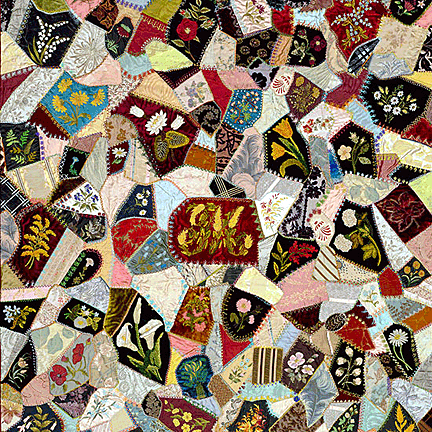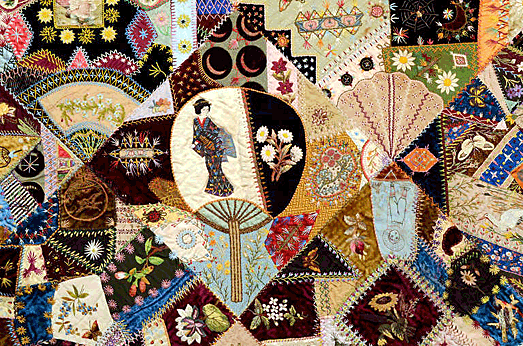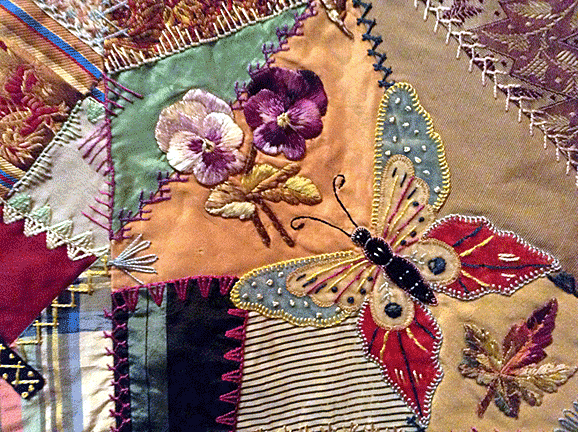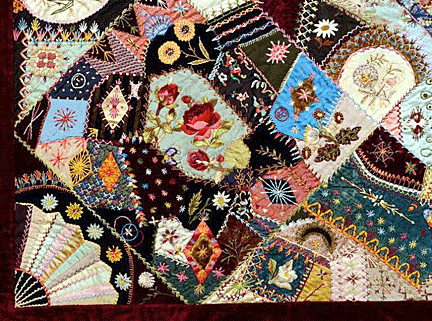|
Still Crazy After All These Years
QUESTION:
 I
recently purchased a crazy quilt at a country antique show. I love the
intricate designs, but, otherwise, don’t know much about it. Can you
tell me more and perhaps tell me how I can take care of it? It’s in
pretty good condition, but I can see that it’s somewhat delicate. I
recently purchased a crazy quilt at a country antique show. I love the
intricate designs, but, otherwise, don’t know much about it. Can you
tell me more and perhaps tell me how I can take care of it? It’s in
pretty good condition, but I can see that it’s somewhat delicate.
Thanks,
Jennifer
__________________________________________________________
ANSWER:
Crazy quilts were the result a fad that began in the United States over
140 years ago, roughly from 1875 to 1900. As with many country quilts,
it became a way for women to use up their extra scraps of cloth or
fabric from worn-out clothes, but crazy quilts also were a form of self
expression, much like samplers were a 100 years before that.

Victorian women created crazy quilts like giant jigsaw puzzles, made of
irregular pieces of silk, satin, velvet, or plush fabric sewn onto a
solid backing of a lighter material, then decorated with embroidery
stitches. Many became sentimental diaries stitched with names and
legends while others took on the look of nostalgic stitched scrapbooks
filled with memorabilia commemorating events, story book characters,
garden flowers, even family pets. Women often made them as gifts to a
bride or to someone recovering from a severe illness. Others made them
in memory of a loved one who had recently passed.
Scraps for these elaborate quilts often came from ball gowns, opera
capes, or the parlor curtains. But women could also buy packages of
scraps from the Montgomery Ward or Sears Roebuck catalogs. The Singer
Sewing Machine Company used crazy quilts as a symbol on their trade
cards. Women's magazines of the day offered directions for making crazy
quilts as table covers along with patterns for decorating them. Silk
manufacturers promoted the use of their scrap waste in making crazy
quilts. Magazine publishers also offered booklets on making crazy quilts
as premiums in exchange for subscriptions to their periodicals.

The word crazy in this case actually means irregular, odd, bizarre,
strange, or unusual, and perfectly describes these quilts. Some look
like a haphazard collection of odd bits of cloth and memorabilia while
others are more like abstract works of silk art in shimmering colors
reflecting light.
Since crazy quilts are more often tufted rather than quilted, they
should be called "throws." Victorian housewives often threw them over
parlor tables and pianos, as well as sofas or beds. They were the
perfect complement to the ornately carved overstuffed furniture and
bric-a-brac of every sort adorning table tops, etageres, and mantels in
the Victorian parlor.
 Some
historians believe the Victorian crazy quilt may have originated as a
result of the popularity of Japanese prints or screens after the
Philadelphia Exposition of 1876. Others wonder if their fractured
designs may have been taken from the pattern of an uneven pavement or
cracked ice, a popular decorative border used from the late 1870s
through the 1880s. Some
historians believe the Victorian crazy quilt may have originated as a
result of the popularity of Japanese prints or screens after the
Philadelphia Exposition of 1876. Others wonder if their fractured
designs may have been taken from the pattern of an uneven pavement or
cracked ice, a popular decorative border used from the late 1870s
through the 1880s.
Likewise, women often copied the patterns painted and embroidered on
crazy quilts from Japanese ones. Many crazy quilts display a cranes
standing in pools of water, owls and peacocks perched on gnarled tree
branches, kimono clad figures, butterflies and cherry blossoms, hanging
lanterns and spider webs.
 And
since not every woman was artistically talented, makers of crazy quilts
could purchase pre-stamped patches or would trace designs from
magazines. The Ladies Home Journal offered as a premium to readers
bringing in 16 new subscribers a “Crazy Patchwork Outfit,” consisting of
12 pre-stamped pieces of silk, one box of stamping powder, twelve skeins
of embroidery silk, and a glittering array of two dozen spangles and two
yards of tinsel cord. And
since not every woman was artistically talented, makers of crazy quilts
could purchase pre-stamped patches or would trace designs from
magazines. The Ladies Home Journal offered as a premium to readers
bringing in 16 new subscribers a “Crazy Patchwork Outfit,” consisting of
12 pre-stamped pieces of silk, one box of stamping powder, twelve skeins
of embroidery silk, and a glittering array of two dozen spangles and two
yards of tinsel cord.
Women's magazines also offered how-to instructions for the three basic
embroidery stitches---the outline, Kensington, and plush. The outline
stitch, also known as the stem stitch, formed a thread line as in a
drawing. The Kensington stitch enabled crazy quilt makers to fill in
their outlines using various colors. And the plush stitch produced areas
of cut silk thread like a pile carpet.
Quilt makers used embroidery stitches not only along the edges of
patches to decorate them and at the same time hold the edges under and
in place but also to make designs. Those who lacked embroidery skills
could purchase pre-embroidered appliques. Some crazy quilt makers
further embellished their creations with painted designs on the fabric
after they assembled their quilts. Sequins, beads, spangles, metallic
braid, and ribbon were also popular forms of embellishment.

In an unprecedented outpouring of sentimentality, Victorian quilters
filled their work with bits and pieces of their personal past: Father's
vest pocket, lace from a wedding veil, ribbons commemorating political
events or visits to faraway lands. A penchant for romantic themes is
also evident, as is a love of oriental motifs.
Making something of nothing to furnish her home in a splendid manner
appealed to the Victorian woman wealthy enough to have servants to do
the housework. Fancy work was acceptable busy work, a cure for
nervousness and other women's complaints.
After 1910 there was little interest in the crazy quilt, which seemed
old fashioned at the time when the public considered Arts and Crafts
designs and four-square Mission furniture modern. If women made crazy
quilts during this time, they were often of wool or of cotton and made
in rural America.
And some women were so proud of their crazy quilts that they signed
them. In fact, these quilts are probably the best documented of all
American quilts because so many of their makers signed them and passed
them down through generations of their families.
Caring for Crazy Quilts
Crazy quilts aren’t as durable as regular quilts. They won’t survive
daily folding and shouldn’t be used as throws where they’ll be handled a
lot. But they can be mounted on a frame or encased in plexiglass and
hung on a wall. Both dry cleaning and wet cleaning damages them, so the
only safe way of cleaning them is to use a low power vacuum held well
away from the fabric which has been covered with some sort of mesh
screening—an old window screen will do—to prevent the fabric from being
sucked up and damaged.
Unlike regular quilts, women who made crazy quilts usually signed them.
Many have been passed down through generations in a family.
Prices for crazy quilts range from $50 for an average small one to as
much as $1000 for a large exceptionally stitched one. Because their
prices are relatively low in comparison with fine 19th-century quilts,
many most likely remain hidden away in attic trunks waiting to be
discovered.
<
Back to Readers Ask Archives
Next Article > |
